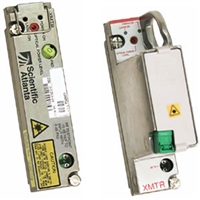 Analog Reverse Optical Transmitters with Thermal Compensation
Analog Reverse Optical Transmitters with Thermal Compensation
The Models 6940, 6942, 6944, GainMaker® and GS7000 Nodes may be equipped with 1310 nm or Coarse Wave division Multiplexing (CWDM) analog reverse optical transmitters to facilitate reverse communications from node to headend or hub site. These reverse optical transmitters are now thermally compensated for improved performance over temperature.
The CWDM reverse optical transmitter is offered in a choice of 8 wavelengths from 1470 to 1610 nm. Up to 8 CWDM reverse optical transmitters can share a common return fiber when used with accompanying multiplexing and demultiplexing passive optics.
All of these reverse optical transmitters incorporate distributed feedback (DFB) lasers, which are best suited for high-capacity reverse traffic. They are available in both standard and high gain versions, in order to allow flexibility in reverse path design. The high gain versions are typically used in the Model 6944, 6942, and GS7000 segmentable nodes. The standard gain versions are typically used in the Model 6940 and GainMaker nodes. All optical transmitters used in the GS7000 Node have a new high profile module cover that includes both a self-contained fiber pigtail storage area and an integrated pull ring for easier module installation and removal.
The reverse optical transmitters specified in this data sheet include both a Power On LED and an Optical Power Alert LED, enabling quick visual confirmation of operational status. A DC test point that is scaled to the optical output power is also included.
Optionally, to help ensure maximum reliability and quick fault resolution, the reverse transmitters can be remotely monitored using the Scientific-Atlanta Transmission Network Control System (TNCS).
 1310nm, 1550nm and CWDM Analog Reverse Transmitters
1310nm, 1550nm and CWDM Analog Reverse Transmitters
The Models 6940, 6942, 6944, and GainMaker® Optoelectronic Receiver Stations (nodes) may be equipped with 1310 nm, 1550 nm, or CWDM (or any combination) analog reverse optical transmitters to facilitate reverse communications from node to headend or hub site.
There are two types of lasers used in the 1310 nm reverse optical transmitters. The distributed feedback (DFB) type is best suited for high-capacity reverse traffic, and can accommodate analog video carrier transmission. The Fabry-Perot (FP) type is lower priced and designed for data carrier transmission applications with less stringent performance requirements.
The 1550 nm reverse optical transmitter uses a DFB laser well suited for high-capacity reverse traffic, and canaccommodate analog video carrier transmission.
The CWDM reverse optical transmitter is offered in a choice of 8 wavelengths from 1470 to 1610 nm. Up to 8 CWDM reverse optical transmitters can share a common return fiber when used with accompanying combining and splitting passive optics. The CWDM reverse optical transmitters use a DFB laser and are well suited for high capacity reverse traffic.
All of these reverse optical transmitters are available in standard and high gain versions, in order to allow flexibility in reverse path design. The high gain versions are typically used in the Model 6944 and Model 6942 segmentable nodes. The standard gain versions are typically used in the Model 6940 and GainMaker node.
A variety of transmitter configurations may be utilized in Scientific-Atlanta® nodes. In the Model 6944 node, four reverse transmitters are used for full four-way (quad) reverse segmentation, with a separate transmitter dedicated to each of the station’s four reverse RF input ports. For two-way (dual) reverse segmentation, two transmitters are used, one for each combined pair of RF input ports. In the Model 6940, 6942 and 6944 nodes, for standard operation (no reverse segmentation) the stations may be configured with either a primary transmitter only, or with both a primary and redundant transmitter. The GainMaker node supports one transmitter.
The reverse optical transmitters specified in this data sheet include both a Power On LED and an Optical Power Alert LED, enabling quick visual confirmation of operational status. A DC test point that is scaled to the optical output power is also included.
Optionally, to ensure maximum reliability and quick fault resolution, the reverse transmitters can be remotely monitored using the Scientific-Atlanta Transmission Network Control System (TNCS).